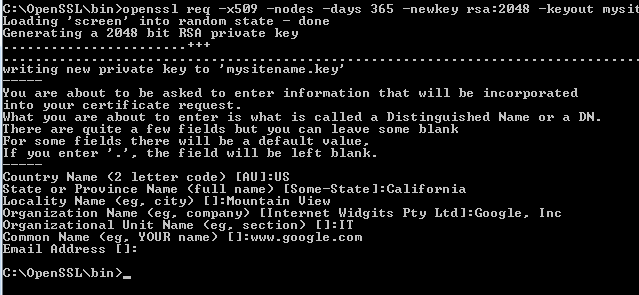Openssl Command Generate Symmetric Key
How to Generate a Symmetric Key byUsing the dd Command
- Openssl Command To Generate Symmetric Key
- Use Openssl To Generate Key Pair
- Openssl Command Generate Symmetric Key System
- Openssl Generate Key File
Symmetric-key algorithms are algorithms for cryptography that use the same cryptographic keys for both encryption of plaintext and decryption of ciphertext. In this tutorial we will demonstrate how to encrypt plaintext using the OpenSSL command line and decrypt the cipher using the OpenSSL C API. The cryptographic keys used for AES are usually fixed-length (for example, 128 or 256bit keys). How to Generate & Use Private Keys using OpenSSL's Command Line Tool These commands generate and use private keys in unencrypted binary (not Base64 “PEM”) PKCS#8 format. The PKCS#8 format is used here because it is the most interoperable format when dealing with software that isn't based on OpenSSL.
A key is needed to encrypt files and to generate the MAC of a file.The key should be derived from a random pool of numbers.
An AES key, and an IV for symmetric encryption, are just bunchs of random bytes. So any cryptographically strong random number generator will do the trick. OpenSSL provides such a random number generator (which itself feeds on whatever the operating system provides, e.g.
If your site has a random number generator,use the generator. Otherwise, you can use the dd commandwith the Solaris /dev/urandom device as input. For moreinformation, see the dd(1M) manpage.
Determine the key length that your algorithm requires.
Listthe available algorithms.
Determine the key length in bytes to pass to the dd command.
Divide the minimum and maximum key sizes by 8. When the minimumand maximum key sizes are different, intermediate key sizes are possible.For example, the value 8, 16, or 64 can be passed to the dd commandfor the sha1_hmac and md5_hmac functions.
Generate the symmetric key.
- if=file
Is the input file. For a random key, use the /dev/urandom file.
- of=keyfile
Is the output file that holds the generated key.
- bs=n
Is the key size in bytes. For the length in bytes, dividethe key length in bits by 8.
- count=n
Is the count of the input blocks. The number for n shouldbe 1.
Store your key in a protected directory.
The key fileshould not be readable by anyone but the user.
Example 14–1 Creating a Key for the AES Algorithm
In the following example, a secret key for the AES algorithm is created.The key is also stored for later decryption. AES mechanisms use a 128-bitkey. The key is expressed as 16 bytes in the dd command.
Example 14–2 Creating a Key for the DES Algorithm
In the following example, a secret key for the DES algorithm is created.The key is also stored for later decryption. DES mechanisms use a 64-bit key.The key is expressed as 8 bytes in the dd command.
Example 14–3 Creating a Key for the 3DES Algorithm
In the following example, a secret key for the 3DES algorithm is created.The key is also stored for later decryption. 3DES mechanisms use a 192-bitkey. The key is expressed as 24 bytes in the dd command.
Example 14–4 Creating a Key for the MD5 Algorithm
In the following example, a secret key for the MD5 algorithm is created.The key is also stored for later decryption. The key is expressed as 64 bytesin the dd command.
Symmetic encryption
For symmetic encryption, you can use the following:
 So, you only log in to your Instagram account and download Instagram videos. This always allows you to download videos and images from your friend’s accounts also.
So, you only log in to your Instagram account and download Instagram videos. This always allows you to download videos and images from your friend’s accounts also.

To encrypt:
To decrypt:
Asymmetric encryption
For Asymmetric encryption you must first generate your private key and extract the public key.
Openssl Command To Generate Symmetric Key
To encrypt:
To decrypt:
Encripting files
You can't directly encrypt a large file using rsautl. Instead, do the following:
- Generate a key using
openssl rand, e.g.openssl rand 32 -out keyfile. - Encrypt the key file using
openssl rsautl. - Encrypt the data using
openssl enc, using the generated key from step 1. - Package the encrypted key file with the encrypted data. The recipient will need to decrypt the key with their private key, then decrypt the data with the resulting key.
Ultimate solution for safe and high secured encode anyone file in OpenSSL and command-line:
Private key generation (encrypted private key):
With unecrypted private key:
With encrypted private key:
With existing encrypted (unecrypted) private key:
Encrypt a file
Encrypt binary file:
Encrypt text file:
What is what:
smime— ssl command for S/MIME utility (smime(1)).-encrypt— chosen method for file process.-binary— use safe file process. Normally the input message is converted to 'canonical' format as required by the S/MIME specification, this switch disable it. It is necessary for all binary files (like a images, sounds, ZIP archives).-aes-256-cbc— chosen cipher AES in 256 bit for encryption (strong). If not specified 40 bit RC2 is used (very weak). (Supported ciphers).-in plainfile.zip— input file name.-out encrypted.zip.enc— output file name.-outform DER— encode output file as binary. If is not specified, file is encoded by base64 and file size will be increased by 30%.yourSslCertificate.pem— file name of your certificate's. That should be in PEM format.
That command can very effectively a strongly encrypt any file regardless of its size or format.
Decrypt a file
Decrypt binary file:
Use Openssl To Generate Key Pair
For text files:
What is what:
-inform DER— same as-outformabove.-inkey private.key— file name of your private key. That should be in PEM format and can be encrypted by password.-passin pass:your_password— (optional) your password for private key encrypt.
Verification
Creating a signed digest of a file:
Openssl Command Generate Symmetric Key System
Verify a signed digest: